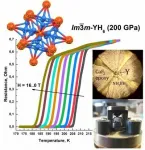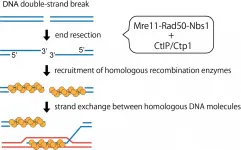Making decisions based on how we feel about memories, not accuracy
2021-03-10
(Press-News.org) When we recall a memory, we retrieve specific details about it: where, when, with whom. But we often also experience a vivid feeling of remembering the event, sometimes almost reliving it. Memory researchers call these processes objective and subjective memory, respectively. A new study from the Center for Mind and Brain at the University of California, Davis, shows that objective and subjective memory can function independently, involve different parts of the brain, and that people base their decisions on subjective memory -- how they feel about a memory -- more than on its accuracy.
"The study distinguishes between how well we remember and how well we think we remember, and shows that decision making depends primarily on the subjective evaluation of memory evidence," said co-author Simona Ghetti, professor at the UC Davis Department of Psychology and Center for Mind and Brain. The work is published March 9 in the journal eLife.
Postdoctoral researcher Yana Fandakova, now an investigator at the Max Planck Institute for Human Development in Berlin, graduate student Elliott Johnson and Ghetti tested objective and subjective memory. After showing volunteers a series of images of common objects, the researchers showed them pairs of images and asked them to determine which of the two they had seen before. The volunteers were asked to rate the memory as "recollected," if they experienced it as vivid and detailed, or as "familiar" if they felt that the memory lacked detail. In some of the tests, image pairs included a target image and a similar image of the same object. In others, the target was shown with an unrelated image from the same original set. For example, a chair might be shown with another chair shown from a different angle, or with an apple.
This experimental design allowed the researchers to score objective memory by how well the volunteers recalled previously seeing an image, and subjective memory by how they rated their own memory as vividly recollected or merely familiar. Finally, participants were asked to select which images to keep or discard, assigning them to a treasure chest or trash bin.
The team also used functional MRI to measure brain activity during this task.
Scoring objective and subjective memory
The results showed higher levels of objective memory when participants were tested with pairs of similar images. But, people were more likely to claim that they remembered vividly when looking at pairs of dissimilar images.
Participants were more likely to base their decision about whether to keep or trash an image on how they felt about a memory rather than its objective accuracy.
To give a real-world example, a person could have a vivid memory of going to an event with friends. Some of the actual details of that memory might be a bit off, but they may feel it is a vivid memory, so they might decide to go out with the same people again (after the pandemic).
On the other hand, if someone has learned to use similar power tools doing odd jobs around the house, their memories about those objects may be quite specific.
"But you might still feel that you are not recalling vividly because you might question whether you are remembering the right procedure about the right tool. So, you may end up asking for help instead of relying on your memory," Ghetti said.
The fMRI data showed that objective and subjective memory recruited distinct cortical regions in the parietal and prefrontal regions. The regions involved in subjective experiences were also involved in decision making, bolstering the connection between the two processes.
"By understanding how our brains give rise to vivid subjective memories and memory decisions, we are moving a step closer to understanding how we learn to evaluate memory evidence in order to make effective decisions in the future," Fandakova said.
INFORMATION:
The work was supported by the James S. McDonnell Foundation.
ELSE PRESS RELEASES FROM THIS DATE:
2021-03-10
Aspirin is an established, safe, and low-cost medication in long-standing common use in prevention and treatment of cardiovascular diseases, and in the past a pain relief and fever reducing medication. The use of aspirin was very popular during the 1918 Spanish Influenza pandemic, several decades before in-vitro confirmation of its activity against RNA viruses. Studies showed that aspirin, in addition to its well-known anti-inflammatory effects, could modulate the innate and adaptive immune responses helping the human immune system battle some viral infections.
With this information ...
2021-03-10
Computer engineers at the world's largest companies and universities are using machines to scan through tomes of written material. The goal? Teach these machines the gift of language. Do that, some even claim, and computers will be able to mimic the human brain.
But this impressive compute capability comes with real costs, including perpetuating racism and causing significant environmental damage, according to a new paper, "On the Dangers of Stochastic Parrots: Can Language Models Be Too Big? ?" The paper is being presented Wednesday, March 10 at the ACM Conference on Fairness, Accountability and Transparency (ACM FAccT).
This is the first exhaustive review of the literature surrounding the risks that come with rapid growth of language-learning technologies, said ...
2021-03-10
Effective, specific, with a reversible and non-harmful action: the identikit of the perfect biomaterial seems to correspond to graphene flakes, the subject of a new study carried out by SISSA - International School for Advanced Studies of Trieste, Catalan Institute of Nanoscience and Nanotechnology (ICN2) of Barcelona and the National Graphene Institute of the University of Manchester, in the framework of the European Graphene Flagship project. This nanomaterial has demonstrated the ability to interact with the functions of the nervous system in vertebrates in a very specific manner, interrupting the building up of a pathological process that leads ...
2021-03-10
Healthcare personnel who were infected with COVID-19 had stronger risk factors outside the workplace than in their hospital or healthcare setting. That is the finding of a new study published today in JAMA Network Open conducted by University of Maryland School of Medicine (UMSOM) researchers, colleagues at the Centers for Disease Control and Prevention (CDC) and three other universities.
The study examined survey data from nearly 25,000 healthcare providers in Baltimore, Atlanta, and Chicago including at University of Maryland Medical System (UMMS) hospitals. They found that having a known exposure to someone who tested positive for COVID-19 in the community was the strongest risk factor for testing ...
2021-03-10
An international team led by Artem R. Oganov, a Professor at Skoltech and MISIS, and Dr. Ivan Troyan from the Institute of Crystallography of RAS performed theoretical and experimental research on a new high-temperature superconductor, yttrium hydride (YH6). Their findings were published in the journal Advanced Materials.
Yttrium hydrides rank among the three highest-temperature superconductors known to date. The leader among the three is a material with an unknown S-C-H composition and superconductivity at 288 K, which is followed by lanthanum hydride, LaH10, superconducting at temperatures up to 259 K), and, finally, yttrium hydrides, YH6 and YH9, with maximum superconductivity temperatures of 224 K and 243 K, respectively. The superconductivity of YH6 ...
2021-03-10
Boston - A new study shows that providing a non-acute care space after hospital discharge for patients with COVID-19 who are experiencing homelessness helped reduce hospitalizations and keep inpatient beds available for those requiring acute care. Published in JAMA Network Open and led by researchers at Boston Medical Center's (BMC) Grayken Center for Addiction, the study demonstrates the importance of developing innovative approaches to tackle issues facing people experiencing homelessness, including their inability to isolate, in order to mitigate additional ...
2021-03-10
Associations between strong predictors of suicidal behaviors over the life course, such as adverse childhood events (ACEs), remain understudied among youth of color. Although not previously considered high risk, suicide attempts among Black youth increased 73% between 1991 and 2017.
Published in the Children and Youth Services Review, University of Minnesota researchers pulled data from the 2016 Minnesota Student Survey (MSS) to examine associations between ACEs, school connectedness and suicide ideation and attempts among Somali, Latino, Hmong and Non-Hispanic ...
2021-03-10
Research published in Environmental Toxicology and Chemistry shows that the presence of polybrominated diphenyl ethers (PBDEs) in bald eagle populations is slowly declining. Bald eagles are apex predators that nest and, more importantly, feed along water bodies, making them excellent bioindicators of environmental contaminants that bioaccumulate up the aquatic food web. The findings are both good news for eagles and instructive for regulators tasked with managing surface water quality by setting protective levels for wildlife, as well as fish consumption advisories for humans.
Lead author Bill Route from the National ...
2021-03-10
Scientists at Tokyo Institute of Technology (Tokyo Tech) have uncovered mechanisms underlying the activation of the MRN complex-- the cell's DNA scissors. Using purified yeast proteins, they demonstrated that phosphorylation of Ctp1, a homolog of a tumor-suppressor protein, plays a key role in activating MRN complex's DNA clipping activity. Intriguingly, a short segment of yeast Ctp1 or its human counterpart could stimulate endonuclease activity of their respective MRN complexes, suggesting its conserved function across species.
DNA functions as a roadmap that guides the identity and functions of cells. A glitch in the DNA ...
2021-03-10
BINGHAMTON, NY -- Star employees often get most of the credit when things go right, but also shoulder most of the blame when things go wrong, according to new research from Binghamton University, State University of New York.
The study explored the potential risks and rewards of collaborating with stars - individuals who have a reputation for exhibiting exceptional performance - and how individual performance factors into how much credit and blame is shared with collaborators.
"Stars are human, and they fail from time to time. We wanted to shift the focus away from stars, and find out what happens to the people who collaborate ...
LAST 30 PRESS RELEASES:
[Press-News.org] Making decisions based on how we feel about memories, not accuracy


